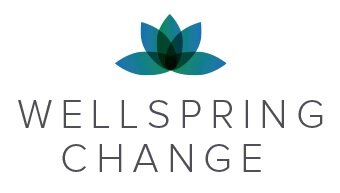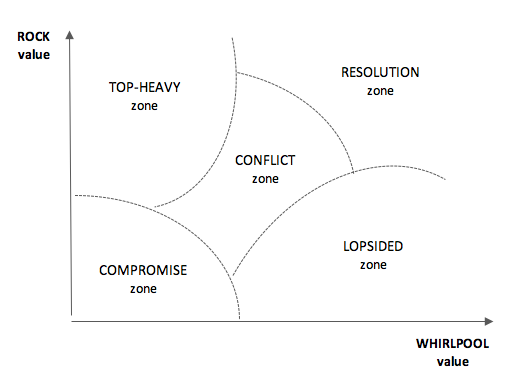by Kirstin Irving - ChangeTools Ltd.
Dilemma: a situation requiring a choice between equally necessary alternatives which are seemingly incompatible”
Life is full of dilemmas, constantly in motion: Should I privilege short-term interests and financial security for today, or take some risk and innovate for the future? Should I drive my team in the direction I believe to be right, or should I invite them to share the multiplicity of ideas they hold? Should I do what is right for me and my family, or what is right for the whole of life on Earth?
Given the tensions that exist, how can we work with the energy of our critical dilemmas to transform the situation and generate ideas for resolution?
In his work on dilemma thinking, Charles Hampden-Turner maps the apparently contradictory values at 90 degrees to one another. Taking the polarised values away from either end of a continuum and turning the line around is an important first step; it changes how we view the nature of the dilemma and how we are able to work with the patterns at play.
In a dilemma, we often find that one of the conflicting values is based around sustaining an existing performance value that is deeply ingrained and well-measured. Known as the ROCK value, it is considered to be the foundation of success. It is strongly protected and feels immoveable.
The other main conflicting value is typically based around change. Known as the WHIRLPOOL value, it is dynamic and considered to be the irresistible force. Capable of keeping pace with or staying ahead of a changing environment, it can be hard to grasp hold of and difficult to predict.
For success through time, both values are needed.
The Five Zones of a Dilemma
To work effectively with the forces at play, we need to understand the five zones of a dilemma:
We find ourselves in the COMPROMISE zone when we avoid the dilemma, deny its existence or accept a compromise in which neither value dimension gets pursued. The result is a downward or degenerative spiral.
Where the rock value dominates, we find ourselves in the TOP-HEAVY zone. Neglect or rejection of the whirlpool value sows the seeds of collapse. Often the rock value dominates through a powerful, though questionable, logic which rejects the whirlpool value as intangible and impractical.
Where the whirlpool value dominates, we find ourselves in the LOPSIDED zone. Neglect or rejection of the rock value sows the seeds of collapse. Often the whirlpool value dominates through a strong energy to overthrow stability or permanence, or through ungrounded enthusiasm.
The CONFLICT zone is where both values are strongly expressed but there is no creative resolution. With the rock and whirlpool values locked in a battle for supremacy, protracted conflict wastes resources. In its destructive form, conflict finds us flipping to the Top-heavy, Lopsided or Compromise zone. In its creative form, however, conflict can be a driver for learning and innovation, with the possibility of a whole new situation emerging.
In the RESOLUTION zone, both rock and whirlpool values are expressed even more strongly, but in a way that involves collaboration, flexibility, accommodation and mutual support. By engaging in a solution-oriented process, the energy that exists in the dilemma is directed to generating ideas for resolution and transformation becomes possible.
“Generative thinking: sparking one idea off of another and creating something new”
Learning to Operate in the Resolution Zone
We can think of navigating a dilemma as a dynamic process similar to sailing a boat: to reach our destination we need to manage the creative tension between the apparently contradictory forces, the tide and the wind, holding them in a generative relationship and making use of timely feedback to tack to and fro, making the best headway possible.
There are different approaches to facilitating this kind of generative process. In our experience, working with constellations is particularly powerful and productive.
Constellations: A Dynamic, Social and Generative Approach
Constellations offers us a radically inclusive approach to navigating dilemmas, honouring and working with all values and views, however unpalatable or discomfiting they may feel to be at the outset.
We begin by working with the owner of the dilemma to get hold of the central issues that are creating the tensions being experienced. We always start with dialogue and prepare to explore the dilemma by identifying a straightforward statement of the main inquiry at hand, for example ‘how can I achieve financial stability today while also taking entrepreneurial risk for the future?’. Often this involves sharing some vision of what it might be like to achieve both values despite the tension.
Through a facilitated process, we create a three-dimensional living map of the dilemma and the dynamics at play. Holding contradictory opposites can be hard for the analytical mind but through constellations we are able to recognise and hold patterns with greater ease.
A fundamental premise of constellations is that everyone and everything in the system – including strongly held, apparently polar opposite, values – have an inalienable right to belong. Through the process, all perspectives and voices are honoured and all are invited to generate ideas for resolution.
By tuning into the dynamics of the dilemma in action, we are able to move beyond the binary. We start to see that strongly-held values all have their own context, background, intelligence and raison d’etre. Assumptions are explored and points of view become better understood.
Calling on the collective wisdom of the system, new insights emerge and previously unimagined solutions are generated and tested.
The dilemma holder leaves the constellation with a greater sense of possibility and often tangible next steps for how to work productively with the explored dilemma. All other participants usually leave with new insights too, given that the essence of the explored dilemma often finds resonance with critical dilemmas of their own.
“Out beyond ideas of wrongdoing and rightdoing, there is a field. I’ll meet you there.” Rumi, 13th Century
Whether you’re navigating dilemmas in the organisations and communities you’re part of or working with the messiness of life closer to home, building your capacity to open to other perspectives, to change some of your views about the ways in which the world works and to learn through creative, solution-oriented processes is key.
Rather than collapsing into compromise, allowing one value to dominate at the expense of the other, or constantly navigating conflict between values without any creative resolution, constellations offer us the potential to go beyond apparently contradictory views to something new.
Learn more about our Landscapes of Change retreat series and how constellations can enable you to make sense of stuck or difficult situations in a way that is transformative and leads to a greater sense of ease and flow.
To learn more about dilemma thinking and other approaches to facilitating resolution, visit H3Uni. Thanks to Bill Sharpe for sharing this work with us.
“Constellations is a very special process, something that’s a real privilege to be part of. I can’t recommend it strongly enough. It’s extraordinary. It doesn’t make sense, but it’s such a powerful, insightful tool.”
Want to find out more…?
If you’re interested in coming to a workshop check out the upcoming ‘Landscapes of Change’ - Retreat Series, or if you’re new to constellations, take a look at my previous blog explaining the background to constellations, and how I work with clients in workshops.
If you want to discuss the possibility of organising a workshop with Marcos or if you’d just like to have an informal chat, please feel free to get in touch.





